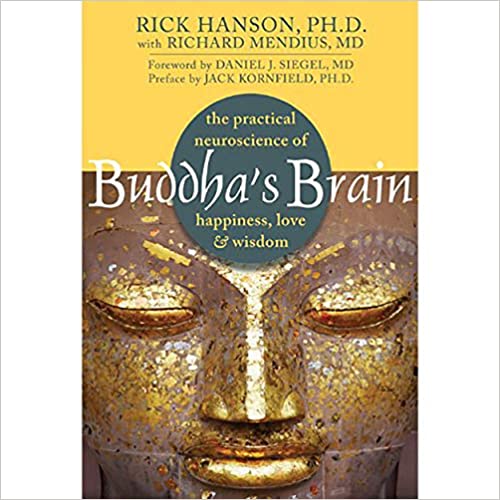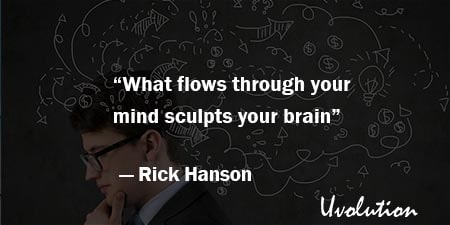Buddha’s Brain by Rick Hanson Summary
The Book in 1 Sentences
Buddha's Brain: The Practical Neuroscience of Happiness, Love, and Wisdom
“This book is about how to reach inside your own brain to create more happiness, love, and wisdom. It explores the historically unprecedented intersection of psychology, neurology, and contemplative practice to answer two questions:
• What brain states underlie the mental states of happiness, love and wisdom?
• How can you use your mind to stimulate and strengthen these positive brain states?
The result is a practical guide to your brain, full of tools you can use to gradually change it for the better.” ~ Rick Hanson
11 BIG Ideas
Buddha’s Brain Book Summary
1. Your Future Self
“It’s a general moral principle that the more power you have over someone, the greater your duty is to use that power benevolently.
Well, who is the one person in the world you have the greatest power over? It’s your future self. You hold that life in your hands, and what it will be depends on how you care for it.”
“It’s impossible to change the past or the present: you can only accept all that as it is. But you can tend to the causes of a better future. Most of the ways you’ll do this are small and humble...
These little actions really add up over time. Everyday, ordinary activities—as well as any personal growth or spiritual practices—contain dozens of opportunities to change your brain from the inside out.
You really do have that power, which is a wonderful thing in a world full of forces beyond your control. A single raindrop doesn’t have much effect, but if you have enough raindrops and enough time, you can carve a Grand Canyon.”
“If I know one thing for sure, it’s that you can do small things inside your mind that will lead to big changes in your brain and your experience of living... You really can nudge your whole being in a better direction every day. When you change your brain, you change your life.”
2. Stimulating The Parasympathetic Nervous System
“Your body has numerous major systems, including the endocrine (hormone), cardiovascular, immune, gastrointestinal, and nervous systems. If you want to use the mind-body connection to lower your stress, cool the fires, and improve your long-term health, what’s the optimal point of entry into all of these systems? It’s the autonomic nervous system (ANS).
This is because the ANS—which is part of the larger nervous system—is intertwined with and helps regulate every other system. And mental activity has greater direct influence over the ANS than any other bodily system. When you stimulate the parasympathetic wing of the ANS, calming, soothing, healing ripples spread through your body, brain and mind.”
“Relaxation engages the circuitry of the PNS and thus strengthens it. Relaxing also quiets the fight-or-flight sympathetic nervous system, since relaxed muscles send feedback to the alarm centers in the brain that all is well.
When you’re very relaxed, it’s hard to feel stressed or upset. In fact, the relaxation response may actually alter how your genes are expressed, and thus reduce the cellular damage of chronic stress.”
“Relaxation drains away anxiety like pulling the plug in a bathtub.”
3. Meditation .. Everyday
“The key to reaping the rewards of meditation is to develop a regular, daily practice, no matter how brief. How about making a personal commitment never to go to sleep without having meditated that day, even if just for one minute?”
4. Desire Vs Craving
“It is sometimes said that desire leads to suffering, but is that always true? The territory of desire is far-reaching, and it includes wishes, intentions, hopes, and cravings. Whether a desire leads to suffering depends of two factors: Is craving—the sense that you need something—involved? And what is the desire for? Regarding the first of these, desire per se is not the root of suffering, craving is.
You can wish for something without craving the results; for example, you can decide to get eggs from the refrigerator without craving them—and without getting upset if there are none left.
Regarding the second factor, intentions are a double-edged sword that can either hurt or help. For example, the Three Poisons—greed, hatred, and delusion—are a kind of intention: to grab pleasure and hold on tight, resist pain and anything else you don’t like, and ignore or distort things you’d rather not know about...
As you weave positive inclinations more deeply into the different levels of your brain, you increasingly push the Three Poisons to the margins. It’s important to nurture good intentions at all levels of the neuroaxis—and to cultivate the strength to carry them out.”
Genpo Roshi - in his great book Big Mind Big Heart - says: “I embrace desires and seeking and fear and distinctions. I embrace them all but I am not bound by them, I’m not attached to them. I can have a desire, and drop the desire if it’s not fulfilled... I don’t get stuck anywhere.”
That’s where it’s at: —> “I can have a desire, and drop the desire if it’s not fulfilled... I don’t get stuck anywhere.”
Edward Deci - in his book Why We Do What We Do - also says: “Whereas earlier studies had focused on issues like the quality of one’s performance and experience, these studies drew direct linkages between the types of motivation and individual’s mental health.
It seems that people who are the healthiest focus on developing satisfying personal relationships, growing as individuals, and contributing to their community. Surely, they also aspire to sufficient financial success to live comfortably.
But wealth, fame, and beauty do not disproportionately occupy the consciousness of these people the way they dominate the experiences of individuals who are less psychologically stable.”
So, remember that “Intentions are a form of desire. Desire per se is not the root of suffering; craving is. The key is to have wholesome intentions without being attached to their results.”
5. Equanimity Game
“Imagine that your mind is like a house without a mud-room—the entry room in cold climates where people put their messy boots and dripping coats. With equanimity, your initial reactions to things—reach for this carrot, push away that stick—are left in a mental mud-room so that the interior of your mind remains clean and peaceful.
The word equanimity comes from Latin roots meaning “even” and “mind.” With equanimity, what passes through your mind is held with spaciousness so you stay even-keeled and aren’t thrown off balance.
The ancient circuitry of the brain is continually driving you to react one way or another—and equanimity is your circuit breaker. Equanimity breaks the chain of suffering by separating the feeling tones of experience from the machinery of craving, neutralizing your reactions to those feeling tones.”
Marcus Aurelius - In his classic book Meditations - tells us: “When force of circumstance upsets your equanimity, lose no time in recovering your self-control, and do not remain out of tune longer than you can help. Habitual recurrence to the harmony will increase your mastery of it.”
Rick Hanson says: “Essentially, modern life takes the jumpy, distractible “mokey mind” we all started with and feeds it steroids.”
6. Unilaterally Virtuous
“Virtue sounds lofty, but it’s actually down to earth. It simply means living from your innate goodness, guided by principle. When you are virtuous no matter what other people do, their behavior is not controlling you.
As a therapist, I’ve seen many couples in which each person says essentially the same thing: I’ll treat you well after you treat me well. They’re stuck in a standoff—which neither one of them truly wants—because they’re each letting the other person determine their behavior.
On the other hand, when you are unilaterally virtuous, you head directly toward your own enlightened self-interest whether or not the other person cooperates. It feels good to be good, enjoying “the bliss of blamelessness” with a mind untroubled by guilt or regret.
Staying principled fosters inner peace by reducing the wrangles that would otherwise weigh on your mind. It increases the odds that others will treat you well in return. If need be, it sets you on the moral high ground.”
And remember that “What flows through your mind sculpts your brain. Thus, you can use your mind to change your brain for the better—which will benefit your whole being, and every other person whose life you touch.”
7. Loving-kindness
“If compassion is the wish that beings not suffer, kindness is the wish that they be happy.
Compassion responds primarily to suffering, but kindness comes into play all the time, even when others are doing fine. Kindness is expressed mainly in small, everyday ways, such as leaving a big tip, reading one more story to a child even though you’re tired, or waving another driver to move ahead of you in traffic.
Kindness has a loving quality, thus the term loving-kindness. Loving-kindness ranges from the casual helpfulness of strangers to the profound love one has for a child or mate. The words “kind” and “kin” share the same root; kindness brings people into the circle of “us” and feeds the wolf of love.”
Hanson advises us “Every morning, establish the intention to be kind and loving that day. Imagine the good feelings that will come from treating people with kindness; take in these feelings as rewards that will naturally draw your mind and brain toward kindness. The results could ripple far and wide.”
8. See The Good
“In general, really nourish and develop positive emotions such as happiness, contentment, and peacefulness. For example, look for things to be happy about, and take in the good whenever possible. Positive feelings calm the body, quiet the mind, create a buffer against stress, and foster supportive relationships—all of which reduce ill will.”
Marci Shimoff -in her great book - Happy for No Reason - also tells us: “Have the intention to notice everything good that happens to you: any positive thought you have, anything you see, feel, taste, hear, or smell that brings you pleasure, a win you experience, a breakthrough in your understanding about something, an expression of your creativity—the list goes on and on.
This intention activates the reticular activating system (RAS), a group of cells at the base of your brain stem responsible for sorting through the massive amounts of incoming information and bringing anything important to your attention.
Have you ever bought a car and then suddenly started noticing the same make of car everywhere? It’s the RAS at work. Now you can use it to be happier. When you decide to look for the positive, your RAS makes sure that’s what you see.”
And remember that “Each of us has two wolves in the heart, one of love and one of hate. Everything depends on which one we feed each day.”
9. What primes you for ill will?
“Be mindful of factors that stimulate your sympathetic nervous system—such as stress, pain, worry, or hunger—and thus prime you for ill will. Try to defuse this priming early on: eat dinner before talking, take a shower, read something inspiring, or talk with a friend.”
“Mindfulness brings insight and wisdom—and the best way to increase your mindfulness is through meditation”
10. In Challenging Situations
“If you think you might get triggered by the interaction and lose your way, help your prefrontal cortex to help you—an interesting circularity!—by sorting out your key points in advance, even writing them down. To keep your words and tone clean, imagine a video recording being made of your interaction: act so that you wouldn’t wince if you saw it.”
11. Mindful.. What does it actually mean?
“We hear the word “mindful” more and more these days, but what does it actually mean? Being mindful simply means having good control over your attention: you can place your attention wherever you want and it stays there; when you want to shift it to something else, you can.
When your attention is steady, so is your mind: not rattled or hijacked by whatever pops into awareness, but stably present, grounded, and unshakable.
Attention is like a spotlight, and what it illuminates streams into your mind and shapes your brain. Consequently, developing greater control over your attention is perhaps the single most powerful way to reshape your brain and thus your mind.”
Mihaly Csikszentmihalyi - in his book Flow - also says: “The mark of a person who is in control of consciousness is the ability to focus attention at will, to be oblivious to distractions, to concentrate as long as it takes to achieve a goal, and not longer. And the person who can do this usually enjoys the normal course of everyday life.”
That was my QUICK summary of the great book Buddha’s Brain by Rick Hanson. If you’re interested, get your copy. There is a HUGE amount of life-changing ideas in this book, and we’ve only touched on a tiny bit of it.
Buy The Book: Buddha’s Brain by Rick Hanson

GET Blinkist 7 Days FREE Trial
3000+ Book Summaries
(Audio and Text)







